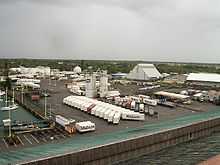Matson, Inc.
 | |
| Type | Public |
|---|---|
| Traded as | NYSE: MATX |
| Industry | Shipping, Navigation |
| Founded | 4/10/1882 |
| Headquarters | Honolulu, Hawaii, USA |
| Area served | United States |
| Key people | Walter A. Dods, Jr. |
| Website | www.matson.com |
Matson, Inc. (formerly known as Matson Navigation Company), is a public shipping company which was founded in 1882.[1] The company provides shipping services Pacific-wide, mainly to and from the Hawaiian islands.[2] Matson is credited with introducing mass tourism to Hawaii with the opening of the historic Moana Hotel (now known as the Moana Surfrider Hotel) and the Royal Hawaiian Hotel in Waikiki on the island of Oahu.
History

William Matson (1849–1917) was the founder of the Matson Navigation Company. He was born in Lysekil in Västra Götaland County, Sweden, and orphaned during childhood. He arrived in San Francisco after a trip around Cape Horn in 1867. Working aboard the Spreckels family yacht, he struck up a friendship with tycoon Claus Spreckels, who financed many of Matson's new ships. In 1882 the three masted schooner Emma Claudina ran to the Hawaiian Islands. The enterprise began in the carrying of merchandise, especially of plantation stores, to the islands and returning with cargoes of sugar. This led to gradually expanding interests at both ends of the line. Increased commerce brought a corresponding interest in Hawaii as a tourist attraction. This interest in Hawaiʻi as a tourist destination soon prompted the construction of the Moana Hotel in 1901. More steamships continued to join the fleet. When Captain Matson died in 1917, the Matson fleet comprised 14 of the largest, fastest and most modern ships in the Pacific passenger-freight service.

The decade from the mid-'20s to mid-'30s marked a significant period of Matson expansion. In 1925, the company established Matson Terminals, Inc., a wholly owned subsidiary, to perform stevedoring and terminal services for its fleet. With increasing passenger traffic to Hawaiʻi, Matson built a world-class luxury liner, the SS Malalo, in 1927. At the time, the Malolo was the fastest ship in the Pacific, cruising at 22 knots. Its success led to the construction of the luxury liners Mariposa, Monterey and Lurline between 1930 and 1932. Matson's famed "white ships" were instrumental in the development of tourism in Hawaii. In addition, beginning in 1927, with the construction of the Royal Hawaiian Hotel, Matson's Waikiki hotels provided tourists with luxury accommodations both ashore and afloat. To generate excitement and allure for Hawaii as a world-class tourist destination, Matson developed an ambitious and enduring advertising campaign that involved the creative efforts of famous photographers such as Edward Steichen and Anton Bruehl. In addition, Matson commissioned artists to design memorable keepsake menus for the voyages, as well as during their stay at the Royal Hawaiian.[3] For a brief period following WW II, Matson operated a luxurious airline using DC-4 aircraft between the Pacific Coast and Hawaii. The airline ultimately ceased operations because of political pressure from Pan American World Airways, which resulted in inability to obtain federal government scheduled operating authority.
Today, Matson continues to ship cargo across the Pacific and plays a key role in the economy of Hawaii, the West Coast and the trading of goods from east to west.
On December 1, 2011, Matson's then-parent company Alexander & Baldwin announced that its board of directors approved a plan to split A&B and Matson into two separate companies. As part of the plan, Matson would leave Oakland, California to become a Honolulu-based company. The two companies are now traded separately.[4]
Operations

Primarily a purveyor of cargo, Matson also introduced into service a number of passenger liners to capitalize on the burgeoning tourist trade. In 1926 Matson took over the Oceanic Steamship Company, operating three trans-Pacific liners, including the SS Sonoma.
From the early 20th century through the 1970s, Matson liners sailed from the west coast ports of San Francisco and Los Angeles to Honolulu and points beyond, including a handful of South Pacific ports of call as well as Australia (Sydney) and New Zealand (Auckland). Two of their earlier cargo liners, the SS Maui and the SS Wilhelmina, were the first passenger ships to place their engines aft. Among the famed "white ships of Matson" were the Malolo (rechristened Matsonia), Lurline, Mariposa and Monterey. With the advent and expansion of routine air travel between the mainland and the islands, Matson's famed passenger service was greatly diminished and the liners were eventually retired from transpacific service and virtually gone by the end of the 1970s.[5]
Matson is still the dominant cargo transportation company in Hawaiʻi. Matson's main competitor in the U.S. domestic market is Horizon Lines.
References
- ↑ "Company profile Matson, Inc.". Businessweek. Retrieved 14 March 2013.
- ↑ "Matson: Hawaiian Shipping Spin-Off Offers Good Prospects". Seeking Alpha. Retrieved 07 March 2013.
- ↑ Matson's History (Matson Navigation Company)
- ↑ Alexander & Baldwin to split into 2 publicly traded companies Honolulu Star-Advertiser
- ↑ History of the Matson Fleet (Matson Navigation Company)
Further reading
- Cushing, John E. (1951). Captain William Matson (1849-1917): From Handy Boy to Shipowner. New York: Newcomen Society in North America. OCLC 654333478.
- O'Brien, Duncan (2008). The White Ships: Matson Line to Hawaii, New Zealand, Australia Via Samoa, Fiji, 1927-1978. Pier 19 Media. ISBN 9780968673416.
External links
| Wikimedia Commons has media related to Matson, Inc.. |
- Matson Navigation Company official website
- The last ocean liners of Matson lines
- The Ocean Linear Virtual Museum - Matson Lines
| ||||||||
| |||||